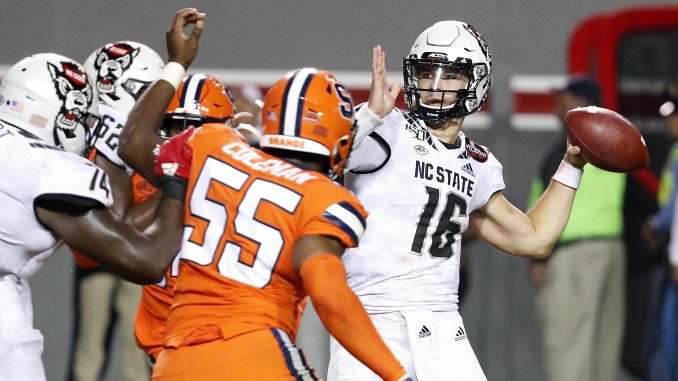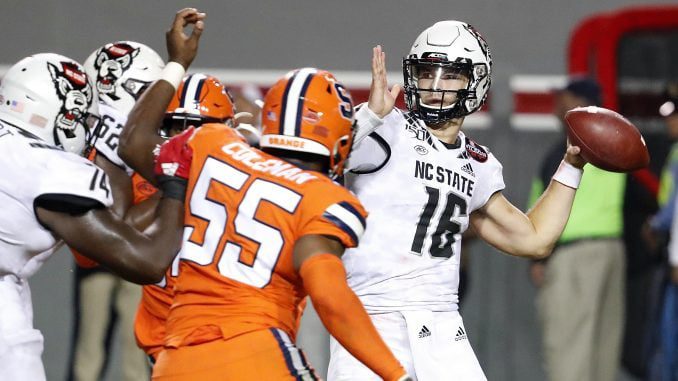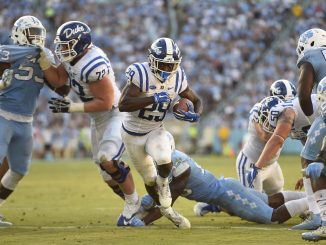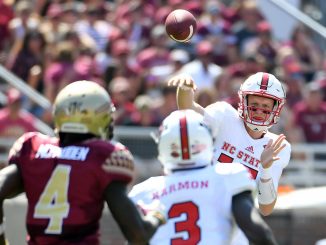

RALEIGH — There’s a reason baseball managers load their lineups with left-handed hitters when a right-handed pitcher is on the mound or with right-handed hitters when facing a lefty.
It’s because the spin of the ball and how it reacts is different depending on the side from which it’s thrown.
The same is true in football.
Only instead of standing at the plate trying to hit the curving ball, receivers have the more challenging task of catching it while adjusting on the run. It’s a skill NC State’s receiving corps is learning to master this season now that southpaw Bailey Hockman has replaced right-handed Matthew McKay as the team’s starting quarterback.
“There’s a huge difference,” said sophomore Thayer Thomas, who ranks third on the team with 19 catches for 227 yards and a touchdown. “The way the ball comes in, one way it’s like this (moving his hand to the right) and with a lefty it comes in like that (switching his hand to the opposite side).
“It makes it different with your hand placement. For me, a lefty is a little bit harder to catch because I’ve never had a lefty quarterback and I’m so used to that righty ball coming in.”
The mechanics of catching the ball aren’t the only thing that changes depending on the arm with which the quarterback is throwing.
As leading receiver Emeka Emezie learned early in Hockman’s first start, on Sept. 28 at Florida State, there are also subtle differences in the way pass routes have to be run.
“On one of the early plays, I ran a deep route and had to adjust to it a little differently,” said Emezie, who has 33 receptions for 358 yards and a touchdown. “When he throws it to the left, it comes back inside, so I had to go back inside to get the ball.”
Hockman — the first lefty to start a game for the Wolfpack since Cam Young did against Virginia on Nov. 8, 1986 — was elevated to the starting job after four games, primarily because of McKay’s inability to throw the deep ball with accuracy and a sputtering offense that had stagnated against Power 5 opposition.
But even before the change, coach Dave Doeren began using Hockman for a series or two each game — just as he’s doing now with new backup Devin Leary, who, like McKay, throws right-handed.
The back-and-forth between righty and lefty was a challenge at first. But Emezie said it’s a complication he and his fellow receivers are learning to handle.
“You just have to deal with it on the run,” Emezie said. “You know there’s a lefty and a righty, but I just try not to think about it anymore and just play with whoever is in.”
The receivers aren’t the only ones that have to make adjustments according to which quarterback is in the game. There’s also a difference in the responsibilities of the blockers whose job it is to protect the passer.
How big a difference, Doeren said, depends on the style of the passer.
“If he’s a stationary guy, it doesn’t matter,” the State coach said. “If he’s a guy that always escapes to one side or the other, it matters for the tackles more.”
Unlike McKay, Hockman is more of a pocket passer, which is good news considering that the Wolfpack’s best blocker — 6-foot-6, 310-pound left tackle Justin Witt — is currently sidelined with an injury.
Under normal circumstances, Witt would likely trade places with right tackle Emanuel McGirt to keep opposing rushers away from his quarterback’s blindside. But because his replacement is true freshman Ickey Ekwonu, the positions have remained the same.
One thing that has changed is the way co-offensive coordinators Des Kitchings and George McDonald call their team’s plays. That is, at least the direction in which those plays are run since, as Doeren pointed out, some quarterbacks have trouble throwing the ball across their bodies.
“When you look at sprint outs and bootlegs, you’re going to find a team right-handed or left-handed based on their quarterback,” Doeren said. “From a play-calling standpoint, you’ve got to be able to flip things in your mind based on who’s in the game.”
Even after two games with Hockman at quarterback, wide receiver Thomas said the process of adjusting remains a “work in progress” as State prepares for Saturday’s game road against ACC Atlantic rival Boston College.
“I feel like we’re all still trying to get used to it,” he said.
To speed up the transition, State’s coaches have reversed the spin on the JUGS machine used to shoot balls out to the receivers in practice to better simulate what they’ll see in the games.
But at this point, Thomas said the biggest challenge is mental rather than physical.
“At first I was thinking different ways for different quarterbacks and it was sort of getting in my head a little bit,” he said. “But I feel like now you’ve got to be more mature about it, go out and make the plays that come your way and not really think about what the quarterback brings to the table. You just have to go out there, win on your route, see the ball, catch the ball and just worry about doing your job.”



